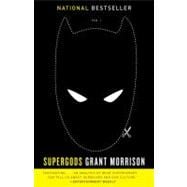
Note: Supplemental materials are not guaranteed with Rental or Used book purchases.
Purchase Benefits
What is included with this book?
Grant Morrison is one of the most popular and acclaimed contemporary writers of any genre. His long list of credits as a comic-book writer include JLA, New X-Men, Seven Soldiers, Animal Man, Doom Patrol, The Invisibles, We3, The Filth, and Batman: Arkham Asylum, the bestselling original graphic novel of all time. He is also an award-winning playwright and screenwriter.
The New copy of this book will include any supplemental materials advertised. Please check the title of the book to determine if it should include any access cards, study guides, lab manuals, CDs, etc.
The Used, Rental and eBook copies of this book are not guaranteed to include any supplemental materials. Typically, only the book itself is included. This is true even if the title states it includes any access cards, study guides, lab manuals, CDs, etc.